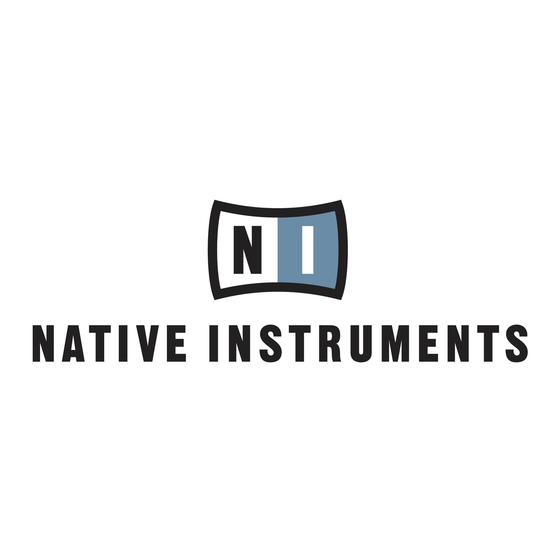Table of Contents
Advertisement
Quick Links
Advertisement
Table of Contents

Subscribe to Our Youtube Channel
Summary of Contents for Native Instruments Retro Machines MK2
- Page 1 Manual...
- Page 2 The information in this document is subject to change without notice and does not repre- sent a commitment on the part of Native Instruments GmbH. The software described by this document is subject to a License Agreement and may not be copied to other media.
- Page 3 Contact Germany Native Instruments GmbH Schlesische Str. 29-30 D-10997 Berlin Germany www.native-instruments.de Native Instruments North America, Inc. 6725 Sunset Boulevard 5th Floor Los Angeles, CA 90028 www.native-instruments.com © Native Instruments GmbH, 2011. All rights reserved.
-
Page 4: Table Of Contents
Table of Contents Table of Contents Welcome to RETRO MACHINES MK2 ................5 What is RETRO MACHINES MK2? ....................5 Using the Instrument ....................6 SYNTH Page ..........................6 2.1.1 OSC section ....................... 7 2.1.2 FILTER section ......................8 2.1.3 AMP Section ....................... -
Page 5: Welcome To Retro Machines Mk2
In addition, the arpeggiator can ei- ther synchronize to your host tempo, or play at it's own rate, depending on your prefer- ence, combined with the Chord In essence, RETRO MACHINES MK2 is pure vintage synth nostalgia combined with ease of use. -
Page 6: Using The Instrument
SYNTH Page Using the Instrument In this chapter, you'll find a description of the RETRO MACHINES MK2 user interface ele- ments, and how to operate them. All presets share the same user interface with only minor differences in the control elements; e.g., where one instrument has a reverb and an echo... -
Page 7: Osc Section
AMOUNT: Sets the amount of modulation applied from the LFO to pitch. ▪ SAMPLE START: Moves the sample start point forward. Useful for making a sound more ▪ static by cutting the sampled filter envelope phase. RETRO MACHINES MK2 - Manual - 7... -
Page 8: Filter Section
The FILTER section in RETRO MACHINES MK2 has four filter types, each capable of subtracting or boosting the original harmonics of the sampled instrument. Although the original synthesizers and keyboards produce the raw signal, it is often the filters from the original instrument itself that give a synthesizer its distinctive sound;... -
Page 9: Amp Section
(volume) of the output signal. In addi- tion, the PERCUSSIVE button provides the means to make instant amp settings for percussive sounds. This provides a good starting point for further enhancement and fine tuning of your own percussive sounds. RETRO MACHINES MK2 - Manual - 9... -
Page 10: Perform Section
MIDI keyboard (or even your computer's keyboard). In Glide mode, the in- strument pitch-bends between two successive notes until the pitch of the second note is reached. The Performance section. RETRO MACHINES MK2 - Manual - 10... -
Page 11: Effects Section
The Effects section. ▪ REVERB: Sets the send level of the Reverb effect. ▪ ECHO: Sets the send level of the Echo effect. ▪ PHASER: Sets the send level of the Phaser effect. RETRO MACHINES MK2 - Manual - 11... -
Page 12: Lfo Section
LFO modulates by using a cyclic repeating wave pattern. The waveforms present in RETRO MACHINES MK2 are Sine, Square, Saw and Random. The rate at which they can be used to modulate the oscillator pitch and the filter cutoff frequency is adjusted with the Rate parameter. -
Page 13: Sound Variations Section
When using and editing Sound Variations, there are a few things to be aware of: ▪ Each Instrument contains a set of eight Sound Variations. All Sound Variations follow a similar convention: ◦ Slot 1 is the basic sound. RETRO MACHINES MK2 - Manual - 13... -
Page 14: Arp And Chord Switch
An arpeggiator automatically steps through a sequence of notes based on an input chord, thus creating an arpeggio. The arpeggiator in RETRO MACHINES MK2 is a modern re-in- terpretation of the arpeggiators found in the original machines. You can choose 16 steps or 12-step triplet mode, and define the velocity of each individual step. - Page 15 ▪ DURATION: Sets the duration of the arpeggiated notes. At maximum, consecutive notes will overlap (useful when SOLO LEGATO in the PERFORM section are activated). PLAY ORDER: Defines the note order for the arpeggiated pattern. ▪ RETRO MACHINES MK2 - Manual - 15...
-
Page 16: Chord Section
(all sliders greater than zero) will be randomized. 2.2.2 CHORD Section RETRO MACHINES MK2 features an advanced approach to playing chords. The Chord Player creates chords from single notes, which is especially useful in combination with the arpeggiator. -
Page 17: Settings Page
You can transpose the chord set with this control. SETTINGS Page The Settings page allows you to configure how your MIDI keyboard's controls (or the KON- TAKT On-screen keyboard's controls) affect the sound of the Instrument. RETRO MACHINES MK2 - Manual - 17... - Page 18 (GLOBAL): If enabled, the controller settings will be applied to all instru- ▪ ments with this option enabled. SETTING RECALL (PRESET): If enabled, the controller settings are specific to the current ▪ instrument. RETRO MACHINES MK2 - Manual - 18...
-
Page 19: Credits
Sound Design: Julian Laping, Thanos Kazakos, Sebastian Müller, Nicki Marinic Graphic Design: Efflam Le Bivic, Cameron Wakal, Kenneth Jensen Sample Processing: Julian Laping Documentation: David Gover and Patryk Korman Samples recorded by Native Instruments, Michael Bernard, Danny Zelonky, Stephan Rühl. RETRO MACHINES MK2 - Manual - 19...




Need help?
Do you have a question about the Retro Machines MK2 and is the answer not in the manual?
Questions and answers